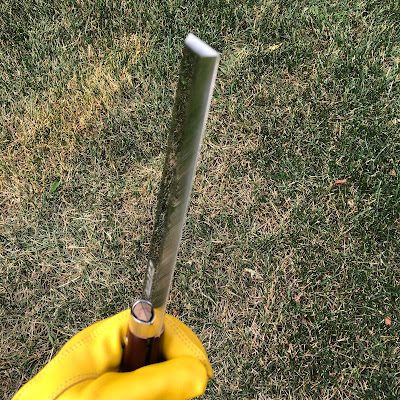A Look At The Nisaku NJP4165 6.5" Blade Stainless Steel Hatchet
Japanese hand tools for farming, wood working, textiles, and more have some pretty interesting designs and variations from western hand tools. Some of them are quite different from what you are used to seeing. A few years ago I was watching the anime Laid Back Camp (aka Yuru Camp) and Rin uses a Japanese Nata hatchet to split some small pieces of wood up for firewood. I hadn't seen a Nata hatchet like that before as it was a long bladed tool, closer to a large bush crafting knife or a smallish machete.
Anyhow, I picked up a Nisaku Japanese Hatchet with a 6.5" blade from Amazon awhile back to see what using this tool was like. I paid around $60 Canadian for this and felt it was a pretty good price from something manufactured in Japan. I had some brush to clear out of my backyard and gave it a bit of a light work out.
 |
| The hatchet out of the sheath. It is a really nice looking bladed tool. |
The hatchet is about .6 lbs, and just over a foot in length. The blade of the hatchet is 6.5" long and is a chisel grind on the bottom and at the tip. It is made of DSR-1 K6 stainless steel which is a pretty good steel, but not top of the line for hardness. The blade was beautifully polished in the version I got to a mirror-like finish and I almost didn't want to try it out. Like many Japanese knives it is not a full tang and there are both rivets and a collar ring binding the blade tightly to the wooden handle. The wooden handle is not thick, but adequate for smaller hands (might feel really skinny for large hands) and has a beautiful deep burgundy finish to it. The blade is also tightly fitted to slot in the handle and it is firmly in place. The nylon sheath was actually kind of dusty / grimy from the warehouse when I got it, but a little soap and water cleaned it up to looking new.
The hatchet has a pretty good weight to it for light swinging and you can use the weight of the blade to knock off small branches and such pretty easily. The blade wasn't razor sharp but was plenty sharp for some splitting, light chopping, and feathering of wood. This was a neat tool and I'll get some more use out of it over time, but I do keep it nice and clean for now as it is pretty well crafted. There are both larger and smaller Natas as this one is medium sized one. If you were bush crafting I would go with a bigger one.
 |
| Blade compared to hand. There are bigger versions of this hatchet, but this is a nice size for light work. |
 |
| The chisel grind. It is double-sided. |
I was wondering how some Japanese woodsmen might use the hatchet too and I found the following Japanese video about a guy batoning wood with it. The video is even in English!
Some Other Gear Posts
- 2022 Comparing the Gerber Dime, NexTool Mini, and Leatherman Squirt Keychain Multi-tools
- 2023 Comparing Gerber, Nextoool, and Leatherman Keychain Pliers-based Multitools (Squirt, Dime, Flagship Mini, Sailor Mini)
- Roxon M2 and M3 Compared With Gerber Dime and Leatherman Squirt
- The Roxon KS2 Pocket Tool compared to Victorinox Huntsman SAK
- My Pocket EDC Pouch - Small and Light Essentials For A Pants Pocket
- Emergency Survival Kit in a Sling Bag
- Personal Toiletry Kit for Airline Carry On Luggage for Canada / USA TSA
- My VSSL Outdoors Gear Supplies Custom Build
- Morakniv Companion Spark Compared to a Similar Chinese Unbranded Bushcraft Knife
- A Look At The Nisaku NJP4165 6.5" Blade Stainless Steel Hatchet
- Unbranded Chinese Multi-tools Comparison and Comment About Leatherman and Gerber
- Japanese Emergency Rations (Disaster Prevention Goods)
- Outdoor Gear / Camping Stores in Tokyo
- Nissin Kanzen (Complete) Meal - European Style Curry Instant Rice Cup Review
- Tasting Kendal Mint Cake, Cliff Builder Chocolate Mint, and Honey Stinger Energy Bars
- Tasting Calorie Mate and Soyjoy. Energy Bars from Japan
- Anime Including Golden Kamuy with Outdoors Foraging For Mountain Vegetables In Japan
Follow me on Twitter or Instagram at @Tostzilla or my feedburner.
More snacks, ramen and Japanese pop culture.















Comments
Post a Comment